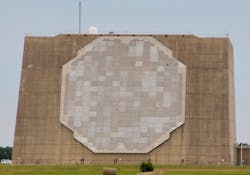U.S. Space Force chooses InDyne to maintain and upgrade early warning radar for ballistic missile defense
PETERSON SPACE FORCE BASE, Colo. – U.S. Air Force needed a company to operate, maintain, and upgrade a ground-based early warning radar system to help protect the U.S. and its allies from enemy ballistic missile attack.
Officials of the Space Acquisition, and Integration Office of the Space Force's Space Operations Command at Peterson Space Force Base, Colo., announced a $63 million contract to InDyne on Monday for the operations and maintenance support of the Perimeter Acquisition Radar Attack Characterization System (PARCS) mission system.
PARCS is a large radar installation that provides ballistic missile warning and attack assessment, as well as space surveillance data to the North American Aerospace Defense Command (NORAD) at Peterson Space Force Base, Colo., as well as to USSTRATCOM and regional combatant commanders.
The PARCS ballistic missile defense radar monitors and tracks more than half of all Earth-orbiting objects with its AN/FPQ-16 phased-array radar system pointed northward over Hudson Bay, and analyzes more than 20,000 tracks per day, from giant satellites to space debris.
The PARCS signal processing group (SPG) consists of 10 cabinets of equipment with hundreds of unique parts. The SPG generates frequency-modulated pulses for transmission, spectrum inversion, and pulse compression; performs side lobe reduction; as well as compares and processes track signals, multiplexing, and signal conversion.
Extensive alignment and maintenance are necessary to maintain proper signal reception and analog digital conversion of the radar system, experts say.
PARCS is a sister ballistic-missile-defense system to the Precision Acquisition Vehicle Entry Phased Array Warning System (PAVE PAWS), and the Ballistic Missile Early Warning System (BMEWS).
PAVE PAWS is a ground-based radar system that provides U.S. Strategic Command (USSTRATCOM) at Offutt Space Force Base near Omaha, Neb., with warning and attack-assessment information on all intercontinental ballistic missiles (ICBMs) launched throughout the world that might be headed for U.S. territory.
BMEWS, meanwhile, is a ground-based radar system that helps warn USSTRATCOM and NATO authorities of submarine- and sea-launched ballistic missile (SLBM) attacks and provides data to help evaluate the severity of ballistic missile attacks.
On this contract InDyne will do the work at Cavalier Space Force Station, N.D., and should be finished by August 2029. For more information contact InDyne online at www.indyneinc.com, or Space Force Space Operations Command at www.spoc.spaceforce.mil.

John Keller | Editor-in-Chief
John Keller is the Editor-in-Chief, Military & Aerospace Electronics Magazine--provides extensive coverage and analysis of enabling electronics and optoelectronic technologies in military, space and commercial aviation applications. John has been a member of the Military & Aerospace Electronics staff since 1989 and chief editor since 1995.

